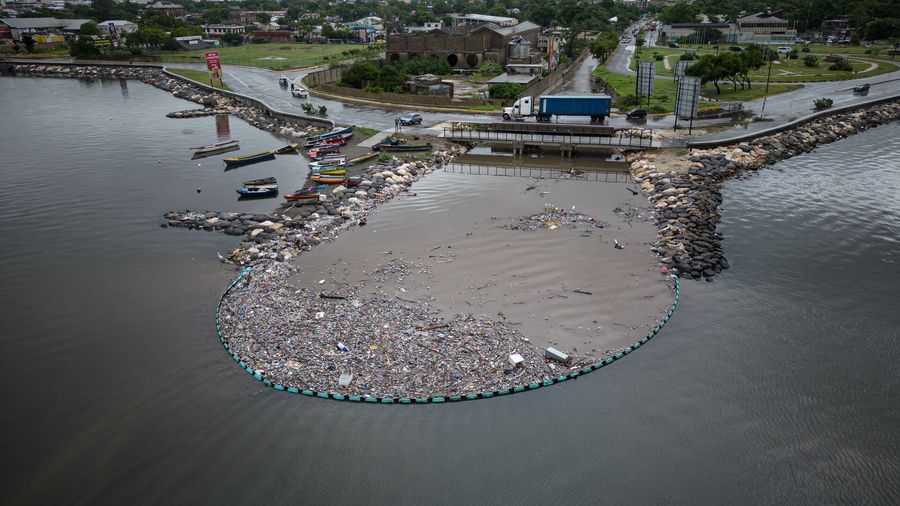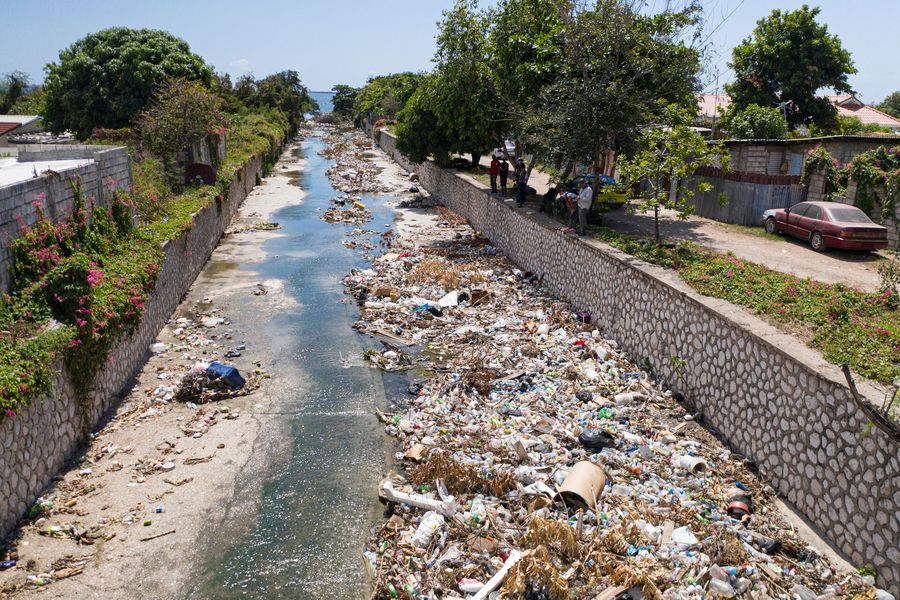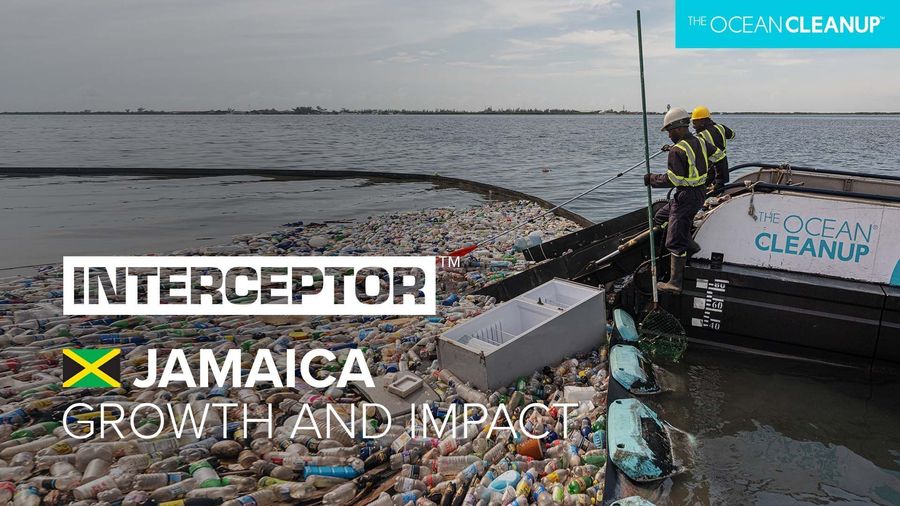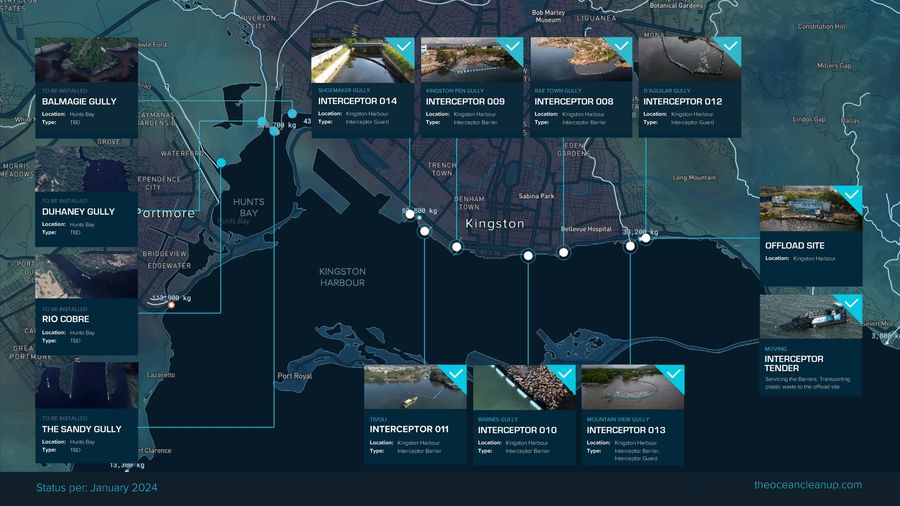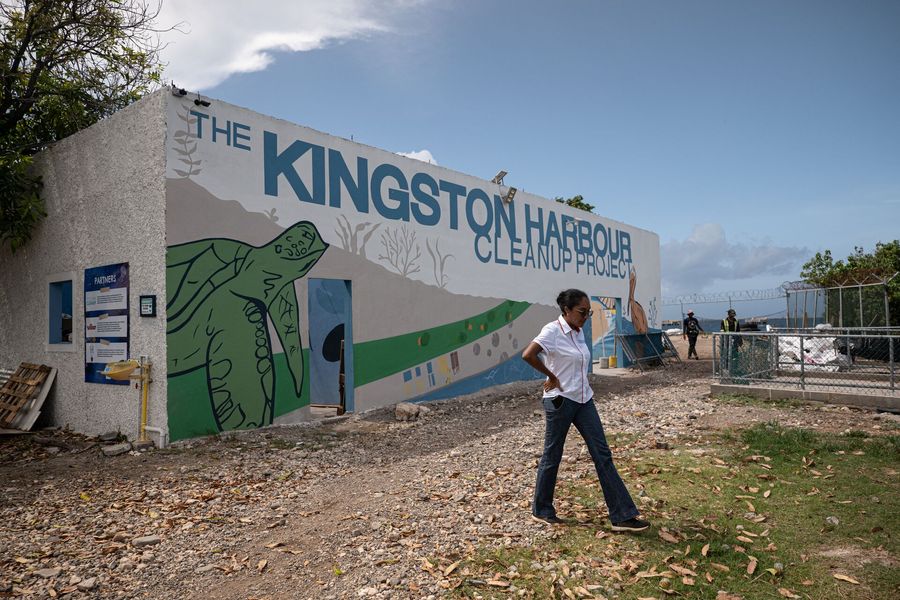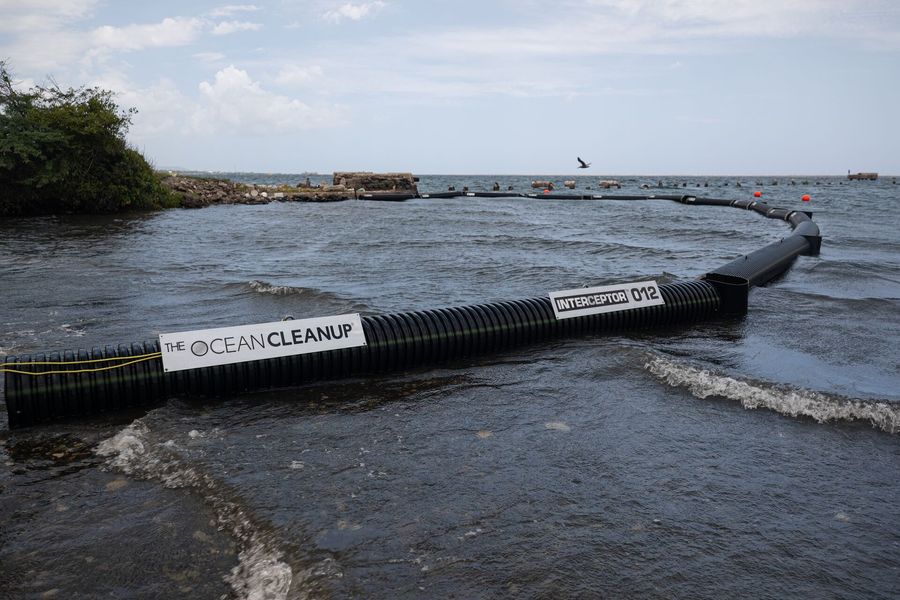
Kingston, Jamaica: The first Interceptor city
Back to updatesThe Ocean Cleanup has now deployed seven Interceptors in the Jamaican capital, completing the first phase of our joint project to eliminate plastic pollution in Kingston Harbour. 2024 will see 4 more Interceptors arrive in Kingston, this time focusing on Hunts Bay, and all aimed at enabling the transformation of the city’s waterways while reducing plastic emissions into the Caribbean Sea.
The iconic city of Kingston: home to legendary music, a cultural heritage second to none – and one of the world’s largest natural harbors.
The Ocean Cleanup has partnered with Clean Harbours Jamaica and the GraceKennedy Foundation to deploy a range of Interceptors throughout the city’s drainage gullies, aiming to prevent an estimated 1000 tons of trash flowing yearly into Kingston Harbour, and further into our shared oceans.
The completion of this first stage marks a key step forward for our joint project in Jamaica. Our objective of tackling the main sources of waste into Kingston Harbour has been completed – now we are ready to move to other challenges in this city, starting with Hunts Bay.
The learnings and data we have gathered so far will allow us to optimize our technology and operations, and expand our network of Interceptors across the city to enable the transformation of its waters with local, regional and global benefit.
FROM GULLY TO OCEAN
A Kingston first-timer may wonder: what exactly is a gully?
A gully is a narrow waterway used to drain water away from a city. In Kingston, water is drained into Hunt’s Bay and Kingston Harbour through a system of these gullies and tributaries. While some gullies are large (such as the enormous Sandy Bay gully, which drains an area of over 50 km2 ), others are narrow and located in heavily populated urban areas. During heavy rains, floods can cause gullies to become heavily polluted with plastic and other municipal debris. This waste can cause serious harm to the local environment, and especially to mangroves, which play a crucial role in maintaining the health of the river’s waters and are already under threat. The waste from these gullies flows directly into Kingston Harbour – and on towards the world-famous waters and coastlines of the Caribbean Sea.
INTERCEPTION: GULLY BY GULLY
The Ocean Cleanup uses a dual strategy to rid the oceans of plastic. Alongside our work to remove legacy plastic in the oceanic garbage patches (starting with the Great Pacific Garbage Patch) we also aim to cut the inflow by intercepting trash in the world’s most polluting rivers. While cleaning the riverine environment, this also prevents plastic reaching the oceans in the first place, and reduces damage to some of our planet’s most renowned Caribbean coastlines.
For each river deployment, we look to target our operations for optimal impact and maximum net benefit for the local community and the wider marine environment. Since our first exploratory visits to Jamaica in 2019 we have been working closely with local authorities and community organizations to find the best solution for the unique characteristics of Kingston’s gullies.
Even if we were able to stop every piece of trash in one gully, this would do little to address the overall problem in the harbor. Waste is not transported to the harbor through one single source, but from many smaller gullies – all of which needed to be individually addressed, and all within a similar timeframe.
In this light, we collaboratively created an innovative new model for trash interception in urban environments: a network of Interceptors in key gullies, technologically adapted for each location and serviced by a common offloading operation for maximum efficiency and tangible impact across the city. The first challenge was to tackle the various gullies bringing an influx of waste into Kingston Harbour.
INITIAL LEARNINGS
Our first Interceptors were deployed in Kingston in 2022, with the arrival of Interceptors 008, 009, 010, 011 to Kingston Pen Gully, Barnes Gully, Rae Town Gully, Tivoli Gully. The Interceptor Tender served as a common harvesting vessel between the Interceptors and the offload site.
Interceptors 012 (D’Aguilar Gully), 013 (Mountain View Gully) and 014 (Shoemaker Gully) followed in 2023.
Technologically, we identified early on that we would require a variety of Interceptor technologies. In general, Kingston’s gullies are too small for solutions such as our Interceptor Original – other options needed to be identified. Combined with the seasonal nature of the waste problem in Kingston, we concluded that customized floating Interceptor models provided the best option.
This also has the benefit of keeping maintenance simple; the oceanic environment of Kingston Harbour means conditions are harsher than in many of our other river operations, and more sophisticated technology may come with a cost to reliability. The Interceptor Barrier was therefore developed alongside the Interceptor Tender for these first three gullies.
During this phase we learned that the windy conditions in the harbor, combined with wakes from passing vessels, can cause the trash captured by the Interceptor Barrier to accumulate in areas which are difficult for the Interceptor Tender to reach. This caused delays during offloading, reducing our efficiency. We are currently developing ‘non-return barriers’ designed to address this problem.
We have increased operational efficiency by adding a second vessel (provided by our partners Clean Harbours Jamaica) to support the Interceptor Tender, allowing us to offload and transport more captured waste at a time. As our catch amount increases, we require more capacity while transporting waste to the offload site. With Interceptors spread across the city including the center, it is essential to maintain an efficient water-based offloading and transport system, as onshore logistics would prove challenging and disruptive. Expanding capacity while continuing to offload in this way has made it easier to scale our operations as we have deployed more Interceptors around the harbor.
Finally, our initial deployments reinforced the importance of strong local operators with expertise and experience in the complex environment and communities that surround it. Our offloading operations are staffed by experienced seamen familiar with the harbor’s characteristics, while our partners use their local expertise to organize outreach and education programs – driving the social change on land that must accompany our immediate action on water.
In particular, the offload site – home of the Kingston Harbour Cleanup Project – has become a hub of community engagement and learning, brightly decorated and frequently visited by schoolchildren from across the region. Our technological and operational expertise, visible for all to see and providing tangible benefits for local residents and businesses, provides the perfect opportunity to educate and share new ways to reduce plastic pollution, manage and recycle waste properly, and help protect these precious waters.
INTERCEPTION TURNED UP TO ELEVEN
The deployment of Interceptor 012 in D’Aguilar Gully marked the debut of the Interceptor Guard, the latest addition to the steadily expanding portfolio of Interceptor Solutions. Our rollout will continue to a total of eleven Interceptors in Kingston.
For each deployment we continue to investigate whether an existing solution, or a novel Interceptor design, or perhaps a combination of components (as successfully seen with Interceptor 006 in Guatemala) is the best option for a particular gully.
The impact of our operations has been clear from the hundreds of tons of waste extracted, positive reactions from local residents, businesses (including local fishing communities) and leaders, and the increasing visibility and awareness of waste management problems and solutions that has accompanied our work. Our Rivers deployments are intended to act as catalysts within a community – intercepting plastic and providing solutions, while enabling a community to drive systemic change further upstream.
Building these relationships provides benefits to everyone. In order to provide maximum net benefit, we consult and engage with local people before, during and after deployments on the location, intention and impact of our work, ensuring we have advanced and informed buy-in from the people who matter most.
This can also help us operationally. For our deployment at Mountain View Gully, for example, heavy vegetation prevented us excavating (as we usually would) to clear trash and make space for the Interceptor. However, local workers were keen to help and formed a team of (paid) workers to clean up the area manually, making space for Interceptor 013. We continually monitor our local impact – we are also collaborating with the University of the West Indies to study the impact of our intervention on mangroves, which play a vital role in protecting riverbanks and stimulating ecosystems. This on-the-ground collaboration ensures that our impact brings local benefit, as well as contributing to cleaner oceans for the whole planet.
Crucially, a clean Kingston Harbour brings us closer to a clean Caribbean Sea. Our Interceptors, with the invaluable support of our partners in Jamaica, are not only capturing huge amounts of waste and preventing it reaching the oceans; they are fast becoming an inspiring symbol of the solution to the waste management challenges in a range of urban environments. Our research shows that coastal cities around the world are the largest source of plastic emissions into our oceans – and the single fastest way to reduce ocean plastic is to target these emissions, and stop them.
Our interception model has evolved and grown since our early deployments, and our results in Jamaica show huge potential for this city-based setup. We are keen to see how these learnings can be applied in other cities around the world.
KINGSTON: A CITY UNITED
We believe that this collaborative format, built around the impact of our Interceptors not only on trash but also on education, awareness and motivation, is the optimal way forward; both for the communities which make it possible for us to intervene, and for the oceanic, coastal and riverine environments we strive to protect.
This is true not only for Kingston, but also for aspirational cities around the globe keen to play their part in ridding the oceans of plastic. Keep watching theoceancleanup.com and @theoceancleanup to see how we have helped transform Kingston Harbour so far, and how we’re moving on to the whole city.


